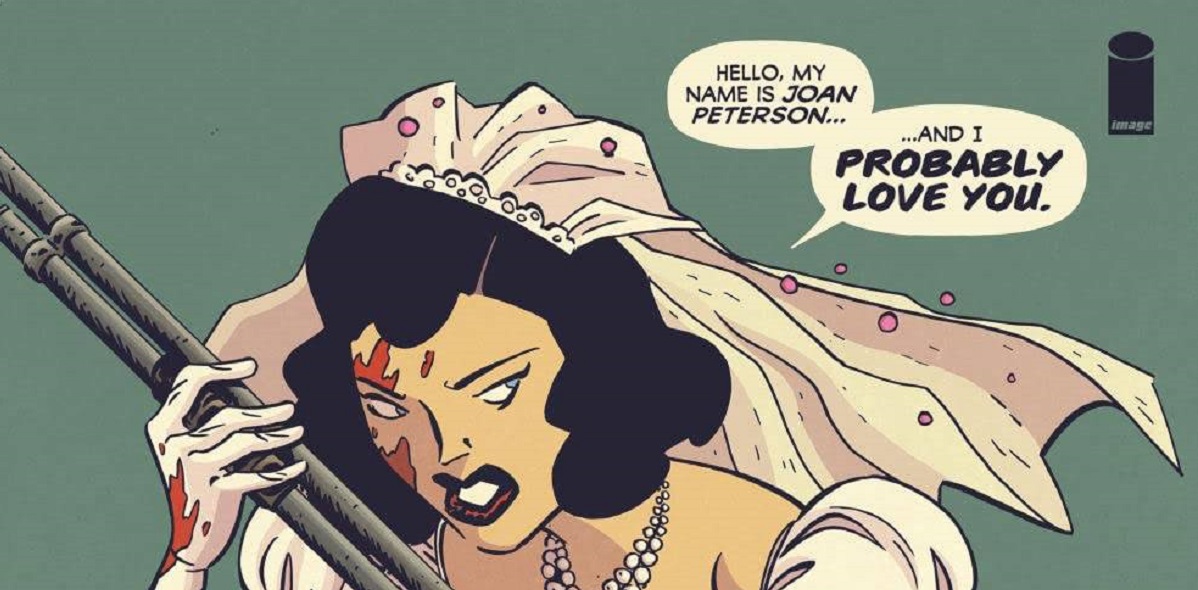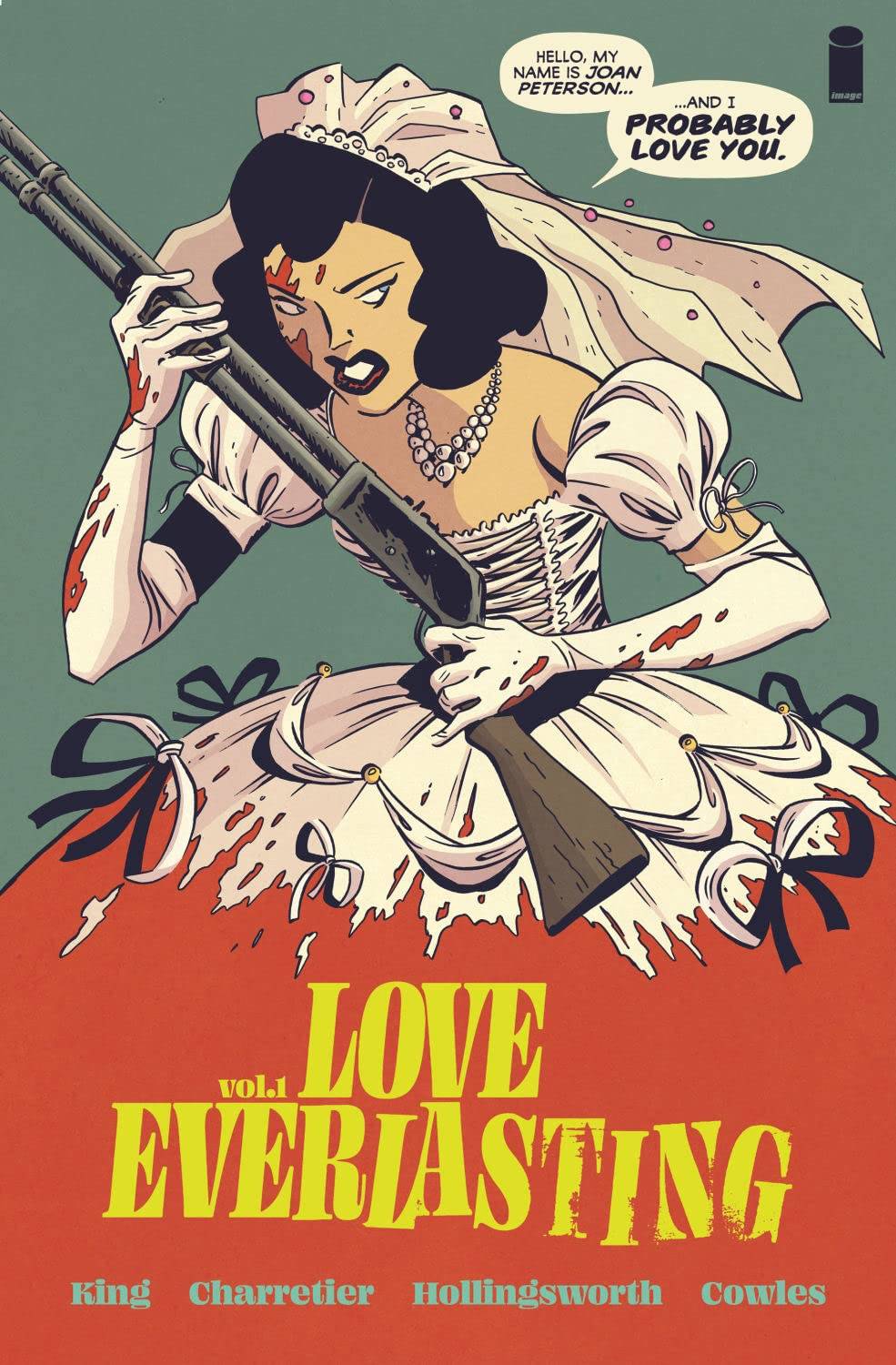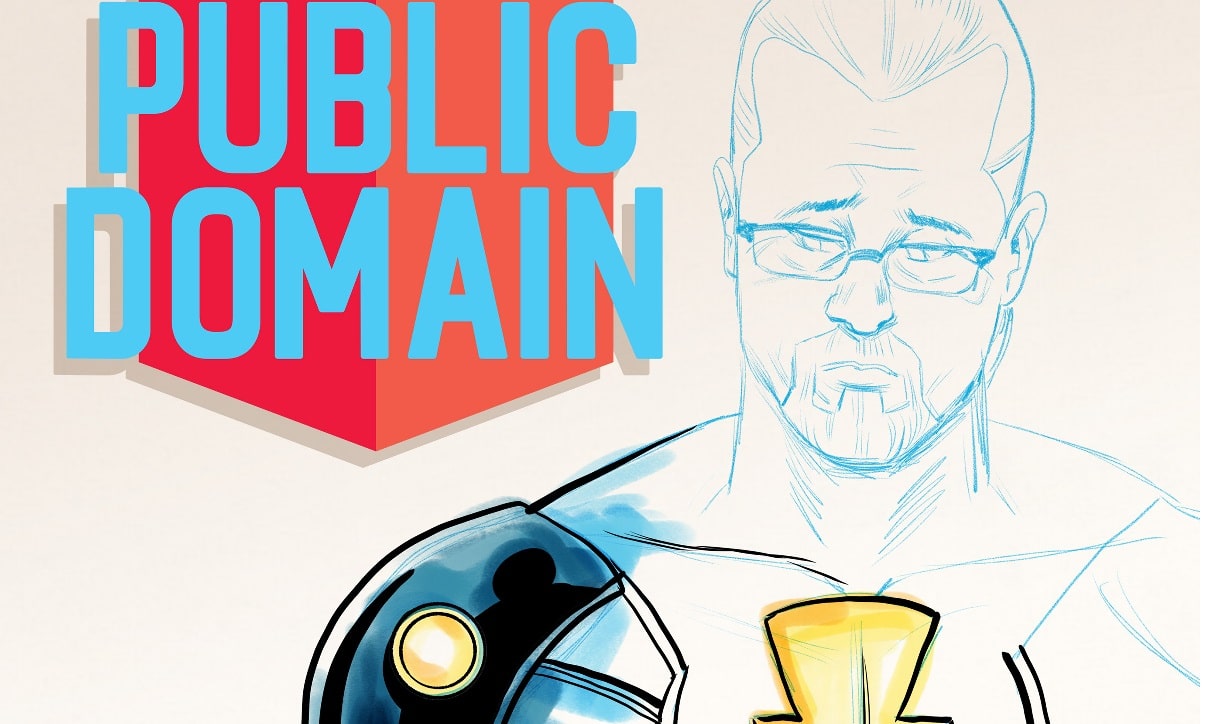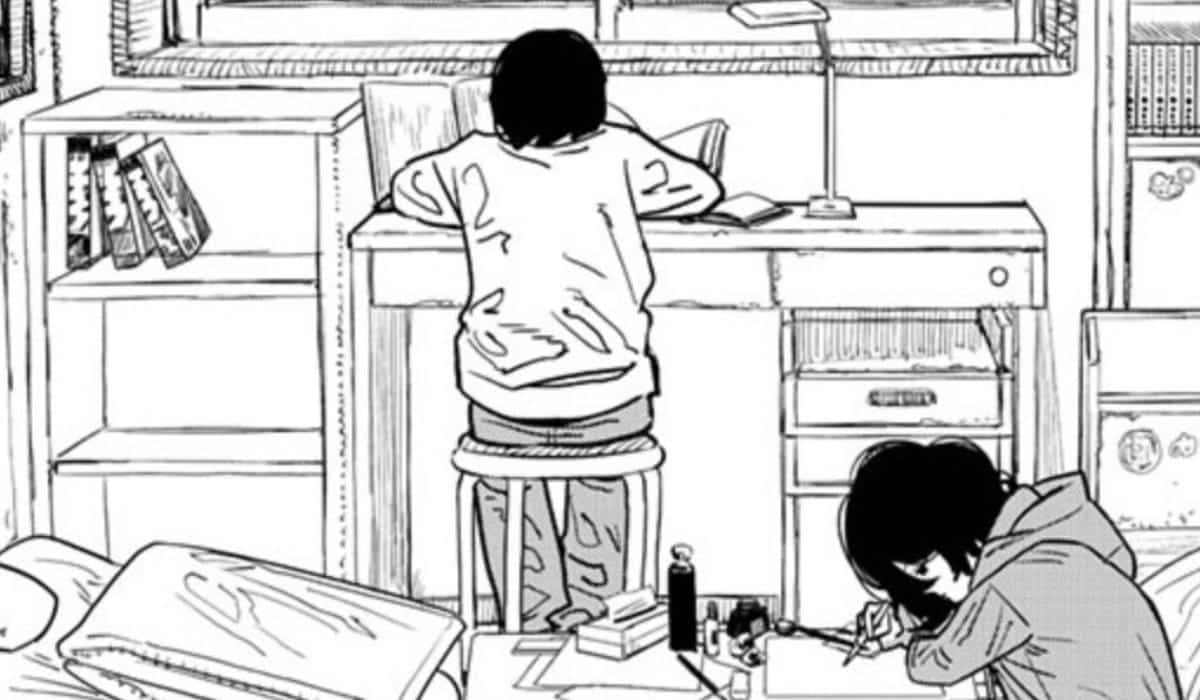Tom King’s superhero work has consistently been appreciated for his focus on romance. Whether it’s the doomed will they/won’t they of Batman and Catwoman or the harrowing emotional anchor of Big Barda and Mr. Miracle, a Tom King comic will inevitably turn its eyes towards love, death, and everything in-between. In each of his attempts to address classically existential themes, King’s work never forgets the relationships that make our choices and our metaphysical views matter and who they will impact the most. In that sense, it ought to come as no surprise that his first venture into creator owned comics is a romance series.
Love Everlasting brings together Tom King and frequent collaborator Clayton Cowles with the art team of Elsa Charretier and Matt Hollingsworth for a unique meditation on the varieties of romantic experience. Love Everlasting is a hybrid of Quantum Leap and Sandman that takes the loose premise of the former to examine the various genres and thematic limits of romance comics, the same way Sandman attempted to do for literary horror. The series feels both completely in King’s wheelhouse but wholly unique in the landscape of creator-owned comics today, and is aided greatly by Charrerier’s iconic style that merges a European Graphic Album approach with a sense of mainstream American pacing.
The tricky balancing act in this first volume is in its need to establish a “how” and “why” that allows the rest to follow without spending too much time in the weeds of exposition. I think this is perhaps its major weakness, where it feels like it’s repeating the same beats of slow realization followed by outrage at the Powers That Be, without ever really getting at the “how’s” or “why’s” in a clear way. How Joan Peterson has become trapped, and why she’s forced to leap from romance to romance isn’t as important as the kinds of romance stories you can tell once you have her in a specific scenario. However, of these first 5 issues, more page space is devoted to articulating these questions than I feel is necessary, especially in comparison to how few true genre examinations we find ourselves with.
The two best stories so far are Issue #2 and Issue #4, both of which are allowed to take their time developing a specific romantic entanglement that poses questions about the circumstances that allow us to fall in love and whether it’s worth it. Issue #2 finds Joan in an Edwardian Aristocratic Romance based primarily in conflicts of class. Joan and Roger grow up together in an abby, her the daughter of a nursemaid and him the first born son of a Lord. The two do not distinguish between social standing but instead bond over the shared experiences of childhood and the burden of their class dictated responsibilities. Joan’s eventual awakening and resistance to the loop she’s trapped in then allows for a direct criticism of the overly sentimental trappings of this type of masterpiece theater-meets-hallmark romance story, and the interchangeable nature of its leading man. There’s nothing to Roger that feels authentically awakened to the absurdity and inhumanity of class divides even if he claims to love Joan, he simply plays the part of someone outraged at not having what they want. This is demonstrated in Clayton Cowles’ letter by Joan being allowed to say “Fuck” while Roger maintains the grawlix censorship. Joan feels something real, and has something to lose. Roger is just part of the set dressing.
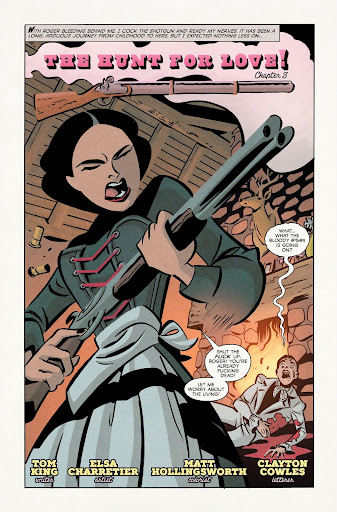
Issue #4 tells a contained love story within the context of war and longing for home. King has told a similar story in Superman: Up in the Sky #3, where Clark is tormented by anxiety over what dangers Lois might be in while he’s not around. Both speak to the reality of being far from home, the fears that come with losing time, and the worst possibilities facing your loved ones in your absence. Both also seem partly inspired by King’s experiences being overseas during his CIA tenure. Love Everlasting #4 follows Joan as a singer in 1915 who meets a freshly recruited soldier named Dane. The story progresses through the years of the First World War, where Dane regularly visits Joan in her bar with one less friend each time as they all die in combat. Dane starts the story adverse to alcohol and is drunk by the end, terrified that he’ll be next now that all his comrades are dead. Joan’s understanding that she’ll forever fall in love only to die parallel’s Dane’s growing fears of the repetitious nature of death around him. This particular tale is less about the messy emotions of being in love, and more about how we can use love as an escape from the harsh realities we cannot accept. Dane holds on to the hope of love in Joan, even though it fails to be reciprocated through the years, because it allows him to keep going. And in the end, if he must die in the trenches, he’d rather do it with the illusion of love.
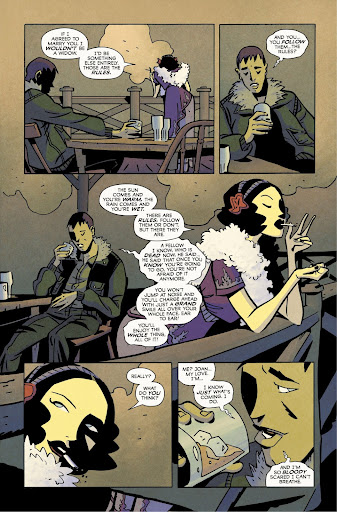
This is where Love Everlasting is at its strongest, and its where King feels most at home as a writer. Each of these stories feel like they are riding the momentum of the art and building towards gut-punching realizations about love and death, and how often one necessitates the other. Love is sometimes described as accepting one’s death as an individual in order to embrace a life with someone else. Joan is eternally in that cycle but each story has the potential to explore what we give up for love, and whether love is worth it.
Even when attempting to explain the rules of this cycle, King is working hard to place Joan in situations that reveal these deeper conflicts over love: should we choose ourselves and go out in the world with no one to hold on to? Or should we allow ourselves to explore a life that can only be created with another?
I think these middle issues of the first arc, 2-4, are ultimately as good as they are because King is allowing Charretier’s art to feel more akin to its loose, emotive style. Charretier has discussed that the art in this series is not in homage directly to any specific romance comic of the past, but rather expresses a modern take on what we feel romance comics were. As such, it’s never drawn in a style that feels like it belongs to the 50s, 60s, or 70s specifically. It’s more universal, sharper, and has a modern understanding of how to pace the story.
However, this is most visible in issues 2-4 because the structure of the book changes noticeable from issue #1. The book originally placed text between panels, literally boxing Joan into her repeating cycle. And while this is a very common feature of comics written by Tom King that artists have enhanced, such as Mitch Gerads in Mister Miracle, it feels less necessary here.
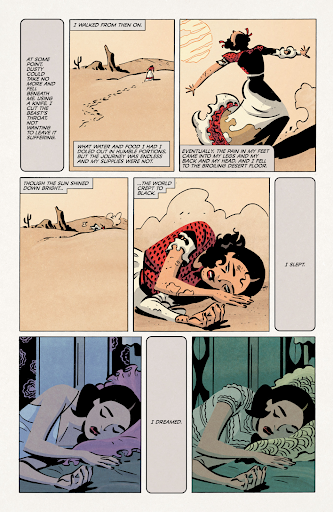
Instead, the book evolves almost immediately by having Joan transgress panel gutters, creating a more engaging dynamic that lets the art speak to the themes directly. Take for example this page from Love Everlasting #4.
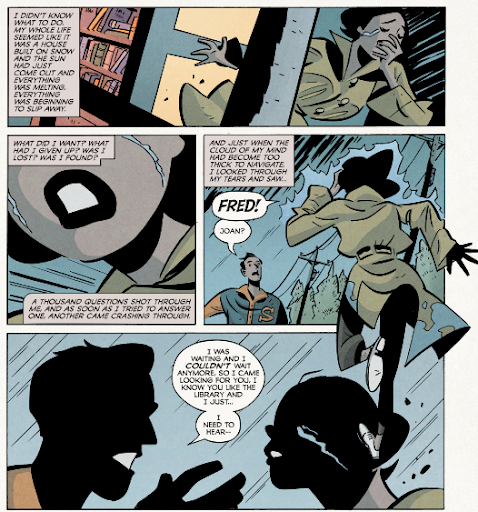
Here Joan feels trapped, unable to decide between finding her way alone or staying with someone she loves. The lettering surrounds her, but she breaks through the panels as she runs to her boyfriend, Fred. The emotion here shifts almost immediately from trapped to freedom as the two share the bottom panel together with the text still separating them, but the movement of the images and the lines of the ran give the whole page a feeling of constant progress, like Joan is ready to break past all the words and finally take action, which she does by finally agreeing to marry Fred. But this is the essence of the trap, falling in love is what leads to the next death and the next love story. So just as she feels freed in this page by making her choice, the subsequent pages of this issue lose the movement and Joan is boxed in once again before dying and repeating the cycle.
This works far better than the first issue’s panel choices because it allows Charretier’s specific style to carry the story in equal measure to King’s writer. The deceptive brilliance of this series is that it’s constantly oscillating between the fairytale two-dimensional romance comics of the past, and the existential horror story beneath the surface. Allowing the pages to then convey that shift between dynamic movement and isolated enclosure feels more engaging as a reader because it always hits on a note “wait… is that really what’s going on?”
Clayton Cowles’ lettering is also playing an active role, not simply in when we see grawlix, by adding to the two poles this comic operates on. King’s dialogue is regularly sparse and poetic. Sentences often are short or repetitive to build up a rhythm that allows two characters to go back and forth in a way that feels extremely natural to read on the page. Cowles has worked with King on a majority of his projects, and usually this specific cadence is captured by having several word balloons stacked on top of each other. Every line is allowed its own space and is constantly on the heels of the next line. Even if there’s an entire full page spread to fill up, the balloons will still huddle together to maintain this specific flow.
Romance comics, and older comics in general, are usually fairly wordy. Dialogue is dense and flowery in a way King does not typically write. Here characters speak in that style, but Cowles chooses to take the larger balloons and allow them to box characters in. The page still reads naturally along the intended eye line, but you’re left with the sense that the promises and the hyperbolic dialogue these characters are speaking defines them in a literal way. They are trapped by their roles and commitment to playing their part.
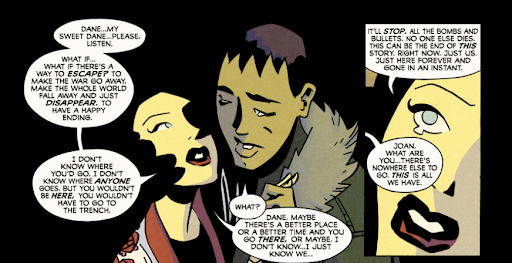
Even the choice to place the last balloon here on top of Joan’s face in order to tell her “This is all we have” feels like an intentional choice to call attention to the premise of the series.
This all adds up to a unique and creatively fascinating series that has seemingly limitless room to grow. The creative partnership with Charretier and Hollingsworth also allows the book to feel unlike anything King has done before, which forces more creative choices both on a script level and artistically. There is no shortage of talent on display and I’m eager to see how this manifests into more stories about the various concepts and limits of love, romance and death that are touched on here so far. As a first arc, this book sets the tone perfectly and leaves me anxious to see Joan’s next adventure. At this point, what it needs to stay in conversation with works like Sandman, Saga, The Walking Dead, or any number of genre bending, creator owned classics is a string of stories that hit on the various ideas of love that this team clearly have.
Love Everlasting Vol 1 is an excellent first date, taking its time to introduce itself, setting appropriate expectations and allowing for surprises that speak to its natural talents and inclination. I can’t wait to see where it takes us next now that it no longer has to set the stage.
Review: Love Everlasting Vol. 1
Love Everlasting Vol. 1
Writer: Tom King
Artist: Elsa Charretier
Colorist: Matt Hollingsworth
Letterer: Clayton Cowles
Publisher: Image Comics
From superstar creators Tom King and Elsa Charretier comes he first volume of a thrilling epic in the tradition of SANDMAN and SAGA. Joan Peterson discovers that she is trapped in an endless, terrifying cycle of “romance”—a problem to be solved, a man to marry—and every time she falls in love she’s torn from her world and thrust into another tear-soaked tale. Her bloody journey to freedom and revelation starts in this breathtaking, groundbreaking collected edition.
Collects LOVE EVERLASTING #1-5
Trade Publication Date: February 14, 2023
Read last week’s edition of TRADE RATING, The Beat’s new weekly series about collected volumes.


